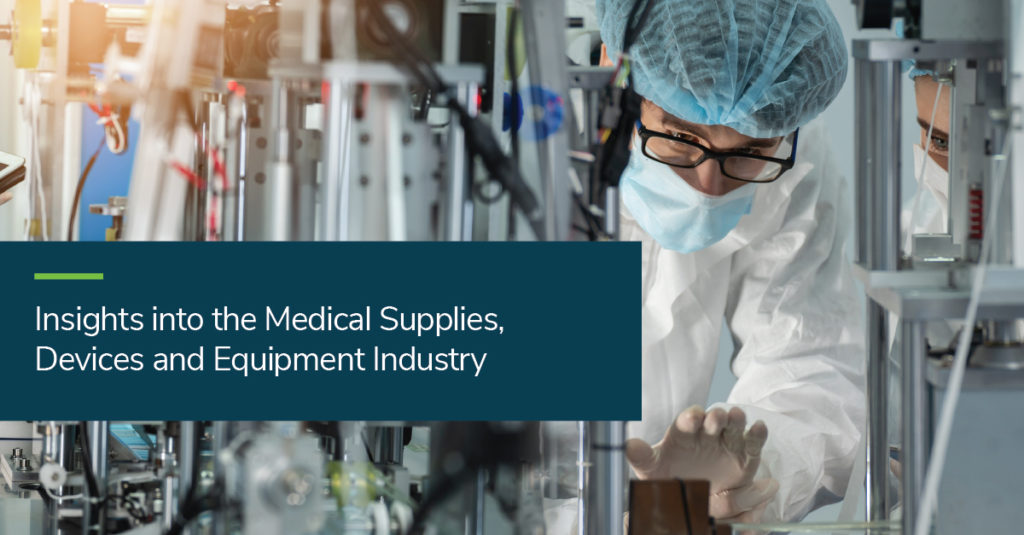
A recent report commissioned by NexTec Group offers insights into the medical supplies, devices and equipment industry. Key Trends Shaping the Medical Devices and Supplies Industry in 2022 explores what’s happening in the industry and the trends medical supplies software and medical devices software manufacturers, developers, and distributors face in the year ahead.
Industry Overview
The guide notes that the “medical supplies industry is constantly evolving, never more so than in the wake of a global pandemic.” To learn how the industry is faring, NexTec spoke with key industry players. The assessment of the last 12 months reveals that growth and obstacles are pairing up to make for a challenging and hopeful 2022.
In the growth column, the guide indicates that the medical devices management industry is on its way up, citing a CAGR of 5% to 2028. “When the pandemic finally begins to diminish, the intense pressure on the healthcare industry will begin to lessen and elective and non-essential services can resume. Because of this, expectations are that the global market will grow substantially.”
However, growth may be counteracted by the high cost of production and maintenance. Costs to produce leading-edge products will be passed on to the consumer, and the consumer may not be in a position to afford it. Additionally, the guide examines the role of regulatory control, calling it a “double-edged sword.”
Though concerning, there are hopeful signs for 2022, including the possible slowing of the pandemic, shifting demographics, positive legislation and emerging markets all point to increasing demand and new opportunities.
Overcoming Challenges
Designed to offer insights, the 2022 medical supplies and devices insight report moves from what’s happening in the industry to what it means, noting, “We have taken our industry snapshot and distilled it down into specific challenges that medical supplies and device manufacturers could face, and what they need to do to overcome them.”
One of the five challenges covered in the guide is the ongoing global supply chain issue. Parts/material delays and shortages have led to manufacturing disruptions and financial losses. According to an article by The Conversation, this particular challenge will persist. “Despite some easing in recent months, international shipping costs are likely to remain high in 2022…Above all, freight transportation and supply chain processes will continue to change during 2022 as more environmentally sustainable practices are adopted.”
Another challenge is the threat of counterfeit or substandard products. Outside of its effects on profitability, it threatens the safety of patients. These falsified, non-compliant products are inserted through what the guide calls “supply chain vulnerabilities.” The answer is to implement stringent supply chain systems and processes that offer a comprehensive view of the supply chain and the ability to identify issues immediately.
Here’s one more challenge: high distribution costs. For industries that have automated their distribution and procurement processes, the healthcare industry has lagged behind. “The sector is still burdened by manual processes and a significant amount of re-work. Such inefficiencies can result in ordering errors, lack of product on hand and expired inventory.”
How Can Medical Supplies and Devices Organizations Prosper in This Changing Environment?
It boils down to increasing visibility into operations, streamlining processes and enabling the company to share data and systems that foster flexibility and agility.
“By finding better and more efficient ways to manage these challenges, companies can remain competitive and improve their bottom line,” the Insight Report notes. “To streamline operations, increase agility and better manage business growth, leading medical supplies and devices companies depend on industry-specific Enterprise Resource Planning (ERP) solutions to ensure success.”
One of the best, highest award-winning ERPs in the industry is Acumatica Cloud ERP . Born in the Cloud, Acumatica supports medical device and supply manufacturing, distribution, inventory control, finances and more. It connects the company end-to-end and makes the company more nimble, so that it can change with the changing situation. Features include financial management, distribution, inventory, production order and tracking, governance and compliance and client management.
DAS Medical Holdings chose Acumatica based on NexTec’s advice. As a result, production and operations efficiency has improved, which is helping to drive the company’s growth. CFO Houston Lee says in their NexTec Customer Story, “[Acumatica’s] manufacturing, inventory control and MRP capabilities are right in line with what we need. Thanks to automated workflows in Acumatica, we’ve increased efficiency and cut the time it takes to report on production activity by over 50%.”
Lee also says, “We have a small accounting department, so we value efficiency, but we also need robust financial controls including a solid audit trail. Acumatica provides that.”
NexTec also helped InBios International, a diagnostic test kit company on the forefront of fighting COVID-19, implement Acumatica. Bryan Deszell, Manufacturing Manager, says, “Along with NexTec, Acumatica was instrumental in ensuring we could get our new diagnostic tests to market as rapidly as we did.”
To learn more about how NexTec and Acumatica can help your company overcome the challenges of the medical supplies and devices industry, download our free Insight Report today. With over 25 years in ERP and several happy medical supplies and devices customers, we can help you, too. Contact NexTec today. We’d love to chat.
